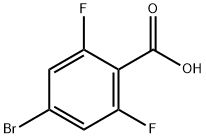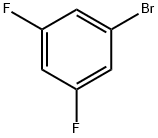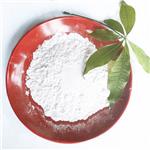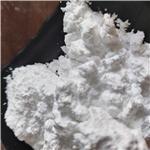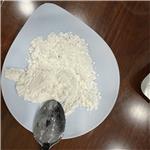Description
4-Bromo-2,6-difluorobenzoic acid (4-Br-2,6-DFA) is an organic compound that holds significant prominence in scientific research. It serves as a crucial intermediate in the synthesis of various organic compounds and finds frequent utilization in laboratory experiments.
Chemical Properties
Off-white Cryst
Uses
In the realm of scientific research, 4-Bromo-2,6-difluorobenzoic acid enjoys wide-ranging usage. It serves as a pivotal intermediate in synthesizing an array of organic compounds. Moreover, its application extends to the synthesis of compounds such as insecticides and herbicides. Additionally, 4-Bromo-2,6-difluorobenzoic acid plays a crucial role in studying enzyme kinetics and has been instrumental in synthesizing diverse peptides and proteins. Although the complete mechanism of action of 4-Bromo-2,6-difluorobenzoic acid remains elusive, it is believed to function as a competitive inhibitor of enzymes like cytochrome P450, along with other enzymes involved in the metabolism of organic compounds.
Application
4-Bromo-2,6-difluorobenzoic acid is recognized as an inhibitor of acetylcholinesterase, an enzyme responsible for acetylcholine breakdown—a neurotransmitter vital for various physiological processes. In summary, 4-Bromo-2,6-difluorobenzoic acid (4-Br-2,6-DFA) is a highly valued organic compound within scientific research. Its extensive applications encompass serving as an intermediate in synthesizing diverse organic compounds, aiding in enzyme kinetics studies, and contributing to the synthesis of peptides and proteins. The precise mechanisms through which it operates are not fully understood, but it is recognized as a competitive inhibitor of certain enzymes.
Synthesis
70 mL of tetrahydrofuran (THF) was cooled to -78 °C and diisopropylamine (4 mL, 28.5 mmol) and n-butyllithium (13 mL, 27.2 mmol, 2.1 M hexane solution) were added sequentially. The reaction mixture was stirred at -78 °C for 1 h, followed by the slow addition of 3,5-difluorobromobenzene (5.0 g, 25.9 mmol) dissolved in 15 mL of THF. Stirring was continued at -78 °C for 45 min. The reaction solution was transferred to a beaker containing solid carbon dioxide and stirred at room temperature for 16 hours. Upon completion of the reaction, the pH was adjusted to 3 with 1N aqueous hydrochloric acid and subsequently extracted with ethyl acetate (EtOAc). The organic layer was collected and dried over anhydrous magnesium sulfate (MgSO4) to afford 2,6-difluoro-4-bromobenzoic acid (5.15 g, 84% yield).1H-NMR (CDCl3) δ 7.20 (2H, m).
References
[1] European Journal of Organic Chemistry, 2003, # 23, p. 4618 - 4624
[2] Bioorganic and Medicinal Chemistry, 2006, vol. 14, # 10, p. 3258 - 3262
[3] Patent: EP3239143, 2017, A2. Location in patent: Paragraph 0181
[4] Patent: CN105859543, 2016, A. Location in patent: Paragraph 0018
[5] Patent: WO2005/12283, 2005, A1. Location in patent: Page/Page column 54
